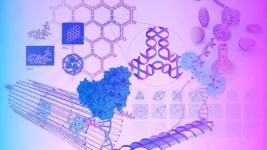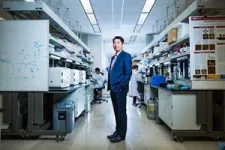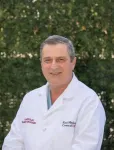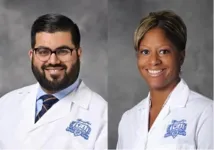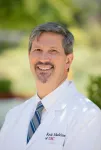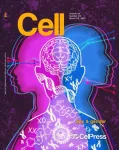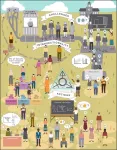(Press-News.org) Hao Yan, director of the Biodesign Center for Molecular Design and Biomimetics at Arizona State University and the Milton D. Glick Distinguished Professor within ASU’s School of Molecular Sciences, has been honored with the Humboldt Research Award by the Alexander von Humboldt-Stiftung Foundation.
This prestigious $65,000 award acknowledges Yan's extensive achievements in research and education.
"The institute is thrilled that the Humboldt Society is honoring Hao for his pathbreaking research and outstanding contributions as a mentor to young scientists,” says Joshua LaBaer, executive director of the Biodesign Institute.
"Hao has been one of the most prolific global leaders in the field of DNA nanotechnology, a rapidly expanding discipline, transforming everything from disease diagnosis and treatment to microelectronics, computation and data storage."
Each year, the Alexander von Humboldt Foundation recognizes up to 100 international researchers of outstanding repute in their respective fields, honoring their comprehensive academic contributions. Recipients are invited to undertake a research initiative in Germany, collaborating with expert peers. The award enables a stay of between six months and a full year, which can be split into multiple stays.
In 2024, the Alexander von Humboldt Foundation symposium will take place in Bamberg, Germany, March 21–24. The 2024 annual meeting is scheduled for June 26–28 in Berlin.
Yan will be hosted by Professor Laura Na Liu, who heads the 2nd Physics Institute at University of Stuttgart. The award presents Yan with the opportunity to foster collaborative endeavors with other notable German scientific institutions.
A trailblazer in DNA nanotechnology and bio-inspired molecular design, Yan's innovative work involves manipulating DNA on a nanoscale (or billionths of a meter). His leadership in crafting designer nanostructures and nanorobots for applications such as cancer detection, imaging, computing and electronics has significantly influenced the DNA nanotechnology research sector worldwide. The tools developed in his lab are crucial to the rapid progression of molecular engineering.
Yan's research has culminated in more than 230 publications, with over 40 in esteemed journals like Science, Nature and Cell, including cover features.
Acknowledged for his dedication to mentoring, Yan has guided more than 30 mentees to faculty positions at institutions worldwide, including Yale, Emory, Rutgers, University of Florida, Tsinghua University, Nanjing University, Chinese Academy of Sciences and the Indian Institute of Technology. His former students have also achieved leadership roles in the chemical and biotech industries.
Yan is an elected fellow of the U.S. National Academy of Inventors (2022), American Institute for Medical and Biological Engineering (2023) and the American Association for Advancement of Science (2019). He is the recipient of the Foresight Institute Feynman Prize in Nanotechnology (2020) and the Rozenberg Tulip Award in DNA Computing (2013).
Other honors include Fast Company’s 100 Most Creative People (2019); Alfred P. Sloan Research Fellowship (2008); National Science Foundation CAREER Award (2006–2011); and Air Force Office of Scientific Research Young Investigator Award (2007–2010). He currently serves as an associate editor for ACS Applied Bio Materials and as an academic associate editor for Science Advances, and has previously served as the president of the International Society for Nanoscale Science, Computation and Engineering (ISNSCE).
END
ASU Biodesign institute scientist Hao Yan receives prestigious Humboldt Research Award
2024-03-14
ELSE PRESS RELEASES FROM THIS DATE:
Henry Ford Health cardiologists lead national study on novel bleeding monitoring system
2024-03-14
DETROIT (March 14, 2024) – Interventional cardiologists at Henry Ford Hospital led a national multi-center clinical study, dubbed the “SAFE-MCS” study, that evaluated the safety of complex high-risk percutaneous coronary intervention (PCI) using mechanical circulatory support (MCS) and surveillance with the Early Bird® Bleed Monitoring System (EBBMS).
PCI is a non-surgical procedure used to treat the blockages in a coronary artery that opens narrowed or blocked sections of the artery, restoring blood flow to the heart.
“This study is the first ...
Ecology: Increasing sea temperatures associated with higher bull shark abundance
2024-03-14
Increasing sea surface temperatures over the past 20 years in Mobile Bay — an estuary in the US state of Alabama — have coincided with five-fold increases in the abundance of juvenile bull sharks (Carcharhinus leucas), according to a study published in Scientific Reports.
Bull sharks are found globally in warm, shallow coastal waters in both fresh and saltwater environments. They help balance and maintain the health of coastal ecosystems by regulating prey populations. Along with great white shark (Carcharodon carcharias) and tiger shark (Galeocerdo cuvier), they are among the shark species that are most like to negatively interact with humans.
Lindsay ...
New study examines if ‘inoperable’ pancreatic tumors can be safely removed
2024-03-14
LOS ANGELES — A clinical trial from Keck Medicine of USC aims to provide a surgical solution for patients with a form of advanced pancreatic cancer previously considered inoperable.
The study will investigate if chemotherapy followed by a novel type of surgery to remove the cancer is a safe and effective option for patients with locally advanced pancreatic cancer, meaning that the cancer has not spread to other organs, but has grown into or close to nearby blood vessels that surround the pancreas.
“Usually, these types of tumors cannot be ...
Terminator-style robots more likely to be blamed for civilian deaths
2024-03-14
Advanced killer robots are more likely to blamed for civilian deaths than military machines, new research has revealed.
The University of Essex study shows that high-tech bots will be held more responsible for fatalities in identical incidents.
Led by the Department of Psychology’s Dr Rael Dawtry it highlights the impact of autonomy and agency.
And showed people perceive robots to be more culpable if described in a more advanced way.
It is hoped the study – published in The Journal of Experimental Social Psychology ...
An electricity generator inspired by the drinking bird toy powers electronics with evaporated water
2024-03-14
Inspired by the classic drinking bird toy, scientists in Hong Kong and Guangzhou, China have developed an engine that efficiently converts energy from water evaporation into electricity to power small electronics. The device produces energy outputs exceeding 100 volts—much higher than other techniques that generate electricity from water—and can operate for several days using only 100 milliliters of water as fuel, according to a study published March 14 in the journal Device.
“The drinking bird triboelectric hydrovoltaic generator offers a unique means to power small electronics in ambient ...
Cell focus issue explores sex and gender in science
2024-03-14
Cell, the flagship biology journal of Cell Press, presents a landmark issue on sex and gender in science. It includes a collection of articles on topics related to strategies for promoting gender equality in academia, enhancing rigor in the study of sex-related variables, and supporting transgender researchers. The special content, scheduled to appear online on March 14, 2024, also discusses the past, present, and future of research on sex and gender.
To mark the occasion, Cell Press’s parent company, Elsevier, is announcing updated guidelines on reporting ...
Transgender scientists speak up about the challenges they face in academia and share how to support them
2024-03-14
A group of 24 transgender (and/or family members of transgender) scientists describe what it’s like to be a transgender person in STEMM. In a commentary publishing on March 14 in the journal Cell, they discuss the historical origins of trans marginalization, explain how this affects trans people’s careers in science and medicine, and lay out actions that cisgender individuals and institutions can take to support trans people in STEMM.
This first-of-its-kind commentary appears in a sex and gender focus issue of Cell, covering topics such as gender equity, the history ...
Sleep-wake rhythm: Fish change our understanding of sleep regulation
2024-03-14
Contrary to common belief, not all vertebrates regulate their sleep-wake rhythm in the same way. University of Basel researchers have discovered that some fish – unlike humans – do not need orexin to stay awake. This molecule was thought to be necessary for normal wake and sleep rhythms in vertebrates. Humans without orexin suffer from narcolepsy.
Until recently, it was assumed that vertebrates share similar mechanisms controlling sleep behavior. That's why researchers have been using fish in the past 20 years as a model organism to study sleep ...
New discovery reveals how the egg controls sperm entry
2024-03-14
After the egg has been fertilized by a sperm, the surrounding egg coat tightens, mechanically preventing the entry of additional sperm and the ensuing death of the embryo. This is according to a new study led by researchers at Karolinska Institutet and published in the journal Cell. The work also explains how mutations in egg coat proteins can cause female infertility and may eventually lead to new contraceptive methods.
Fertilization in mammals begins when a sperm attaches to the egg coat, a filamentous extracellular envelope that sperm must penetrate ...
Teen pregnancy and risk of premature mortality
2024-03-14
About The Study: Teen pregnancy was associated with future premature mortality in this study of 2.2 million female teenagers. It should be assessed whether supports for female teenagers who experience a pregnancy can enhance the prevention of subsequent premature mortality in young and middle adulthood.
Authors: Joel G. Ray, M.D., M.Sc., of the University of Toronto, is the corresponding author.
To access the embargoed study: Visit our For The Media website at this link https://media.jamanetwork.com/
(doi:10.1001/jamanetworkopen.2024.1833)
Editor’s Note: Please see the article for additional information, including other authors, author contributions ...
